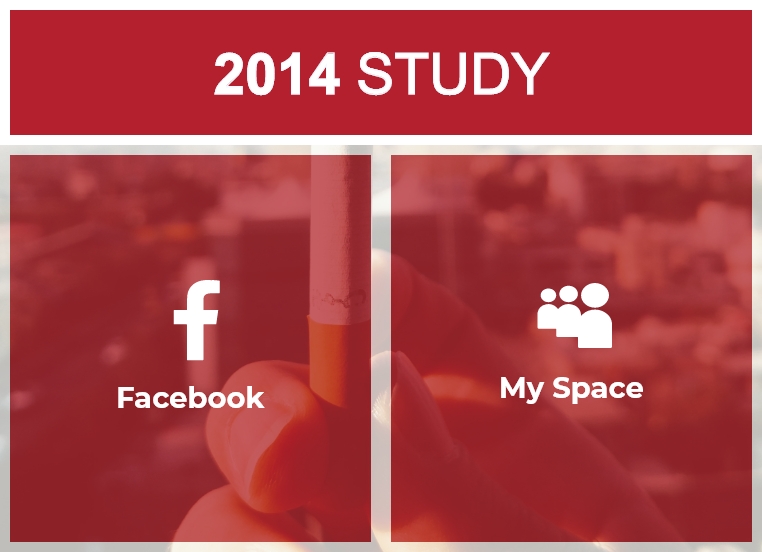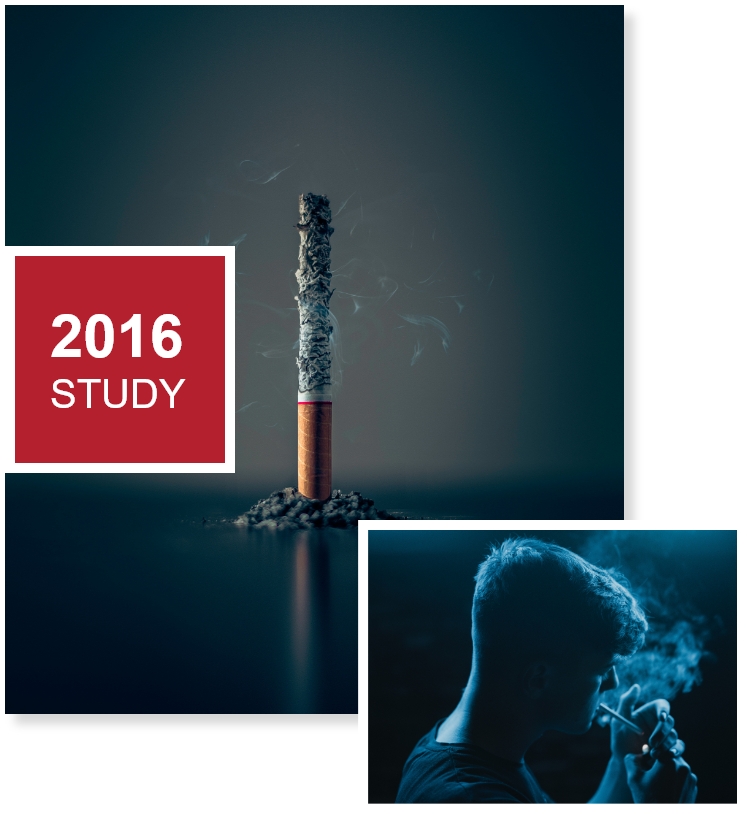
The relationship between tobacco marketing and smoking behavior has been extensively researched. The accumulated evidence base shows a strong causal relationship between tobacco promotion and increased tobacco use.
Media depictions of tobacco use beyond traditional paid mass media advertisements have been documented and assessed for their potential to increase youth smoking uptake and normalize tobacco use.
Entertainment media content such as movies1,2,3, music videos, online videos, television programmes4, streaming services5,6, social media posts, video games7,8, and mobile phone applications have all been shown to depict and promote tobacco use and tobacco products in ways that may encourage youth smoking uptake. The majority of this entertainment media content is being viewed in the modern era through mobile devices and the internet.

Social media has also been used to generate favourable attitudes towards tobacco
A 2014 study found that among youth who never used tobacco, exposure to tobacco promotions via Facebook/My Space was associated with a higher likelihood of thinking that people who smoked looked cool and had more riends; were more willing to smoke if a friend offered; and were less likely to believe that all tobacco products and second-hand smoke were dangerous. There was also a statistically significant association between exposure to tobacco ads and intent to try cigarettes soon.
Source: Cavazos-Rehg P. A., Krauss M. J., Spitznagel E. L., Grucza R. A., Bierut L. J. The hazards of new media: youth’s exposure to tobacco ads/promotions. Nicotine Tob Res 2014; 16: 437–44. Available at: https://academic.oup.com/ntr/article/16/4/437/1172282

A 2016 Australian study found that past-month exposure to Internet-based tobacco advertising and branding among young people increased over the years of the survey.
- The participants who were younger, female, from lower socioeconomic status, and never-smokers were more likely to report exposure.
- Facebook was the most commonly cited platform for encountering tobacco branding.
- In 2013, participants in 2010 were significantly less likely to report exposure to tobacco branding on social media.
- Among never-smokers aged 12-17 years, exposure to online advertising and branding or branding alone were significant predictors of smoking susceptibility.
Source: Dunlop S, Freeman B, Perez D. Exposure to Internet-Based Tobacco Advertising and Branding: Results From Population Surveys of Australian Youth 2010-2013. J Med Internet Res 2016;18(6):e104
https://pubmed.ncbi.nlm.nih.gov/27338761/
DOI: 10.2196/jmir.5595
In a study that measured tobacco and alcohol content in the most popular video games in the United Kingdom of Great Britain and Northern Ireland and assessed the relationship between exposure to tobacco or alcohol content and smoking or drinking behaviours in British adolescents, it was found that adolescents who had played at least one game were significantly more likely to have ever tried smoking – adjusted odds ratio of 2.70, 95% confidence interval (CI) = 1.75–4.17.
Source: Cranwell, J, Whittamore, K, Britton, J, Leonardi-Bee, J. (2016). Alcohol and Tobacco Content in UK Video Games and Their Association with Alcohol and Tobacco Use Among Young People. Cyberpsychol Behav Soc Netw, Jul 1, 19(7), 426-434. doi: 10.1089/cyber.2016.0093. Available at: https://www.ncbi.nlm.nih.gov/pmc/articles/PMC4948204/
A 2011 review of 19 longitudinal studies of adolescents aged 18 or younger who were non-smokers at baseline suggests that exposure to tobacco advertising and promotion in a variety of ways is associated with an increased likelihood of adolescents initiating smoking.
Source: Lovato C., Watts A., Stead L. F. Impact of tobacco advertising and promotion on increasing adolescent smoking behaviours. Cochrane Database Syst Rev 2011; 10. doi:10.1002/14651858.CD003439.pub2. Available at: http://cochranelibrary-wiley.com/doi/10.1002/14651858.CD003439.pub2/abstract
In 2012, the United States of America Surgeon General’s report titled “Preventing Tobacco Use Among Youth and Young Adults”, stated that: “The evidence is sufficient to conclude that there is a causal relationship between depictions of smoking in the movies and the initiation of smoking among young people.”
Source: Preventing tobacco use among youth and young adults. A report of the Surgeon General. 2012 https://www.surgeongeneral.gov/library/reports/preventing-youth-tobacco-use/full-report.pdf
1 Farrelly MC, Kamyab K, Nonnemaker J, Crankshaw E, Allen JA. Movie smoking and youth initiation: parsing smoking imagery and other adult content. PLoS ONE 2012;7:e51935.
2 Arora M, Mathur N, Gupta VK,Nazar GP, Reddy KS, Sargent JD. Tobacco use in Bollywood movies, tobacco promotional activities and their association with tobacco use among Indian adolescents. Tob Control 2012;21:482-7.
3 Morgenstern M, Sargent JD, Engels RC, Scholte RH, Florek E, Hunt K, et al. Smoking in movies and adolescent smoking initiation: longitudinal study in six European countries. Am J Prev Med 2013;44:339-44.
4 Truth Initiative. While you were streaming: Tobacco use sees a renormalization in on-demand digital content, diluting progress in broadcast and theaters. January 2018. See: https://truthinitiative.org/smokescreens
5 Cranwell, J., Murray, R., Lewis, S., Leonardi‐Bee, J., Dockrell, M. and Britton, J., 2015. Adolescents’ exposure to tobacco and alcohol content in YouTube music videos. Addiction, 110(4), pp.703-711.
6 Cranwell, J., Opazo-Breton, M. and Britton, J., 2016. Adult and adolescent exposure to tobacco and alcohol content in contemporary YouTube music videos in Great Britain: a population estimate. J Epidemiol Community Health, 70(5), pp.488-492
7 Cranwell, J., Whittamore, K., Britton, J. and Leonardi-Bee, J., 2016. Alcohol and tobacco content in UK video games and their association with alcohol and tobacco use among young people. Cyberpsychology, Behavior, and Social Networking, 19(7), pp.426-434.
8 Barrientos-Gutierrez T, Barrientos-Gutierrez I, Lazcano-Ponce E, Thrasher JF. Tobacco content in video games: 1994-2011. Lancet Oncology. 13(3): 237-238. 2012. doi:10.1016/S1470-2045(12)70099-2


